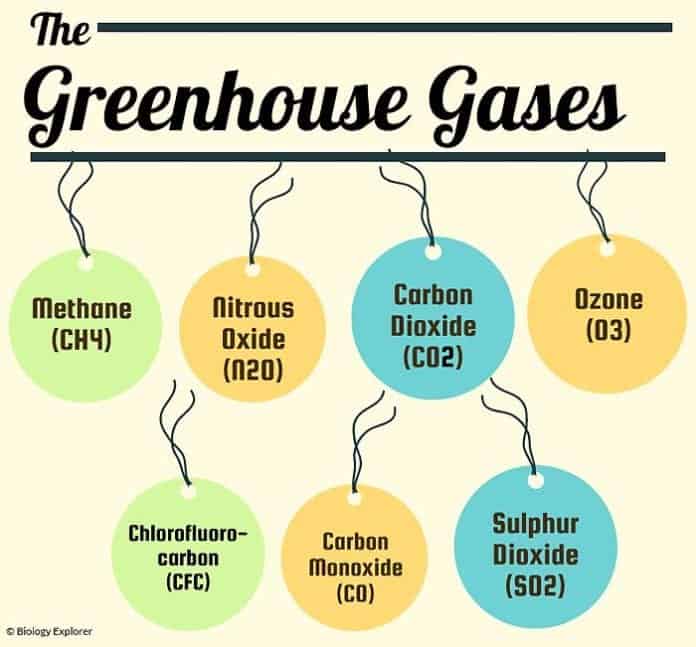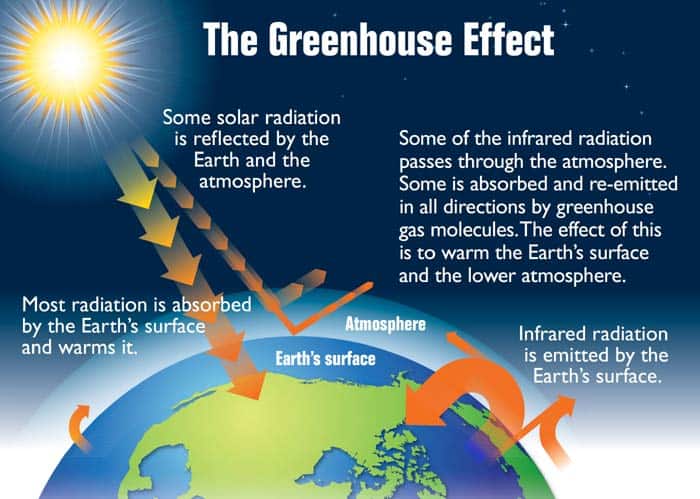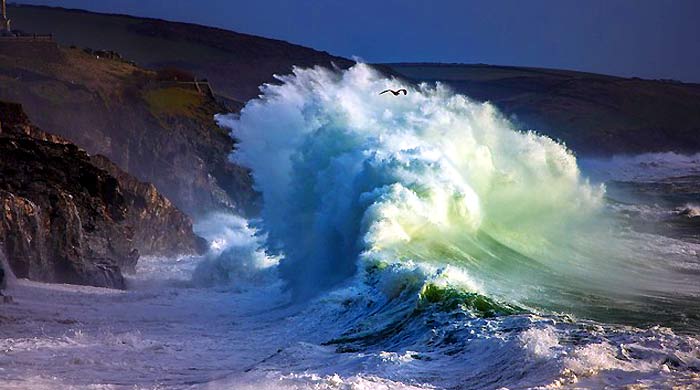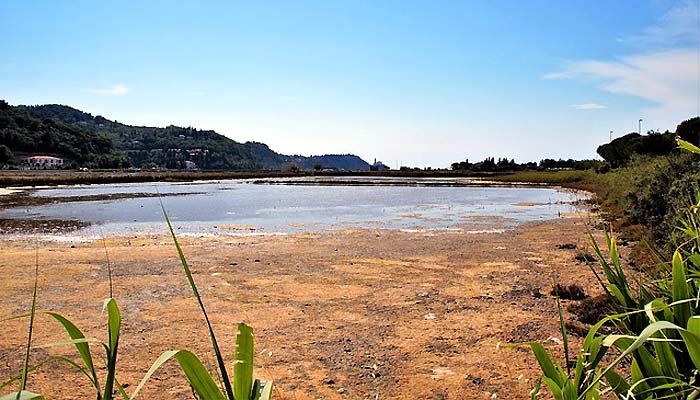
Greenhouse Gases: Several decades ago, humans thought about the idea of altering the weather and climate to their own advantage. With that in mind, they thought of preventing the coming of new ice ages and producing more rains in places of drought.
These seemingly impossible hopes eventually became realities. Unfortunately, today, humans want the opposite–their goal has become the mere stabilization of climate, particularly mitigating the impact of greenhouse gases.
Behind the struggle to combat increasing global temperature and rapidly changing climate lies the excessive production of greenhouse gases that eventually get trapped in the atmosphere.
On this page, we will explore these greenhouse gases, their types, and most importantly, their contributions to climate change.
Table of Contents
What Are Greenhouse Gases?
The sun naturally bombs the Earth with significant amounts of radiation that comes in various forms: visible light, infrared (IR) light, ultraviolet (UV) light, etc. When sunlight reaches the Earth, some radiation from the sun is absorbed by the surface of the land, whereas some portions are reflected. Now, this is where greenhouse gases come into place.
- A greenhouse gas is an atmospheric gaseous substance that can sufficiently absorb infrared radiation. Greenhouse gases got their name from the typical greenhouse used during plant cultivation.
- Greenhouses can maintain temperature because of the transparent glasses that favor the entry of sunlight. This sunlight then warms the air inside the structure but does allow this warmed air to get out.
- Such a phenomenon is similar to the atmospheric greenhouse effect. During a greenhouse effect, the molecules of these greenhouse gases absorb the heat and reflect them to the surface. Because of this, the temperature in the Earth’s atmosphere and land surface increases.
- Hence, with greater amounts of atmospheric greenhouse gases, more radiation will be reflected, causing an increase in temperature.
- Naturally, a greenhouse effect is considered an essential phenomenon that helps maintain the Earth’s temperature. Without it, the planet’s temperature would fall to just -18° Celsius compared to +14° Celsius. At this point, the greenhouse effect should not be considered a synonym for global warming.

![]()
Types of Greenhouse Gases
In general, greenhouse gases constitute just almost 1% of the total gases present in the atmosphere. Their concentrations are dependent on the balance between the “sources” and “sinks” that function to create and destroy these gases, respectively. Anthropogenic activities tend to increase these concentrations by either introducing new types of gases in the air or intervening with the sinks.
- The most abundant greenhouse gases in the Earth’s atmosphere are carbon dioxide, methane, nitrous oxide, ozone, and chlorofluorocarbons. Additionally, atmospheric water vapor also contributes to the greenhouse effect. Fortunately, its cause is believed to be non-anthropogenic.
- Since the industrial revolution, the levels of greenhouse gases in the atmosphere have increased significantly. Alarmingly, the increase has resulted in a so-called radiative-forcing effect where heat is trapped inside the Earth’s atmosphere, thereby contributing to the increase in global temperature.
- The increase in the amount of carbon dioxide (CO2) accounts for more than half of this effect, compared with other gases like methane (CH4), nitrous oxide (NO), ozone (O3), and chlorofluorocarbons (CFCs) which account for 16%, 5%, 12%, and 12% respectively.
- However, according to scientific studies, methods to reduce the production of greenhouse gases and emission of aerosol should not be assumed to rapidly decrease the impacts of climate change.
![]()
Characteristics of Greenhouse Gases
| Type of Greenhouse Gas | Origin | Sink | Contribution To Greenhouse Effect |
|---|---|---|---|
| Carbon dioxide (CO2) |
|
|
|
| Methane (CH4) |
|
|
|
| Nitrous oxide (N2O) |
|
|
|
| Ozone (O3) | Chemical reactions that involve oxygen | All catalytic chemical reactions that involve nitrous oxide, hypochlorite, and hydroxyl species | Absorption of infrared and ultraviolet radiation |
| Chlorofluorocarbon (CFC) | Industrial production | Photolysis and reaction with oxygen |
|
| Carbon Monoxide (CO) |
|
|
|
| Sulphur Dioxide (SO2) |
|
|
Forms aerosols, which scatter solar radiation |
![]()
Effects of Too Much Greenhouse Gases in the Atmosphere
Climate change, as its name suggests, refers to the change in the weather pattern distribution in the Earth’s atmosphere. Alarmingly, this change can last long and, after reaching a certain threshold, can become irreversible.
Unfortunately, greenhouse gases and the greenhouse effect are the number one drivers of climate change. The following are some of the most common effects of greenhouse gases.
![]()
1. Global Warming

As alluded to earlier, the greenhouse effect is not synonymous with global warming, but rather a phenomenon caused by it. The increase in greenhouse gases in the atmosphere reduces the out-flux of infrared radiation, resulting in a warmer temperature. Changes in the Earth’s temperature will trigger other phenomena like changes in wind patterns and variations of cloud covers.
![]()
2. Rise in Sea Level

Aside from those that were mentioned above, global warming can also cause the rise in sea level. The increase in temperature results in the thermal expansion of seawater and melting of the ice and glaciers in some regions like Greenland and Antarctica, thereby adding water to the total water in the ocean. Several studies predict that the Earth’s sea level will become ten times higher (from 0.09 meters to 0.88 meters) in the next 90 years if global warming continues.
![]()
3. Effects on Biological Cycles

Because of higher temperatures, it is expected that biological cycles will be affected as well. One of the most affected is the hydrological cycle. Because the atmosphere becomes relatively warmer than it was, the amount of evaporation is also expected to increase. In other words, this means that a higher amount of precipitation will be experienced. On the other hand, global warming also contributes to the loss of coastal areas and other habitats, thereby reducing organism population and diversity.
![]()
4. Economic and Agricultural Impacts

Because of higher carbon dioxide in the atmosphere, photosynthesis can readily occur, making plants grow at a faster rate. However, too much heat can also affect soil and water conditions, causing them to wilt and eventually die. When this happens, agricultural production, as well as economic growth, will be affected
![]()
Issues like the greenhouse effect, global warming and climate change are not new in the field of science. As alluded to in the introductory paragraph, they have been thought about for decades. However, as the world becomes more industrialized, people are more likely to experience the devastating effects of these greenhouse gases.
As a citizen of this planet, what can you do to decrease the emissions of greenhouse gases as well as to alleviate the effects of climate change?























As a citizen, what I think is:
First, stop using fossil fuels.
Second, use renewable energies in every domain such as Aviation, Industry, Transportation, Homes domestic, and Energies grid.
Finally, do afforestation and deforestation in order to trap the CO2 in the atmosphere.
SO2 is not a greenhouse gas. Please correct your information.
Hi Sean Richards,
I see that the Sulphur Dioxide is still considered a greenhouse gas, but it is a short-lived greenhouse gas compared to other greenhouse gases from anthropogenic sources, which are long-lived.